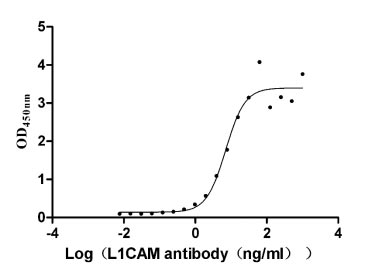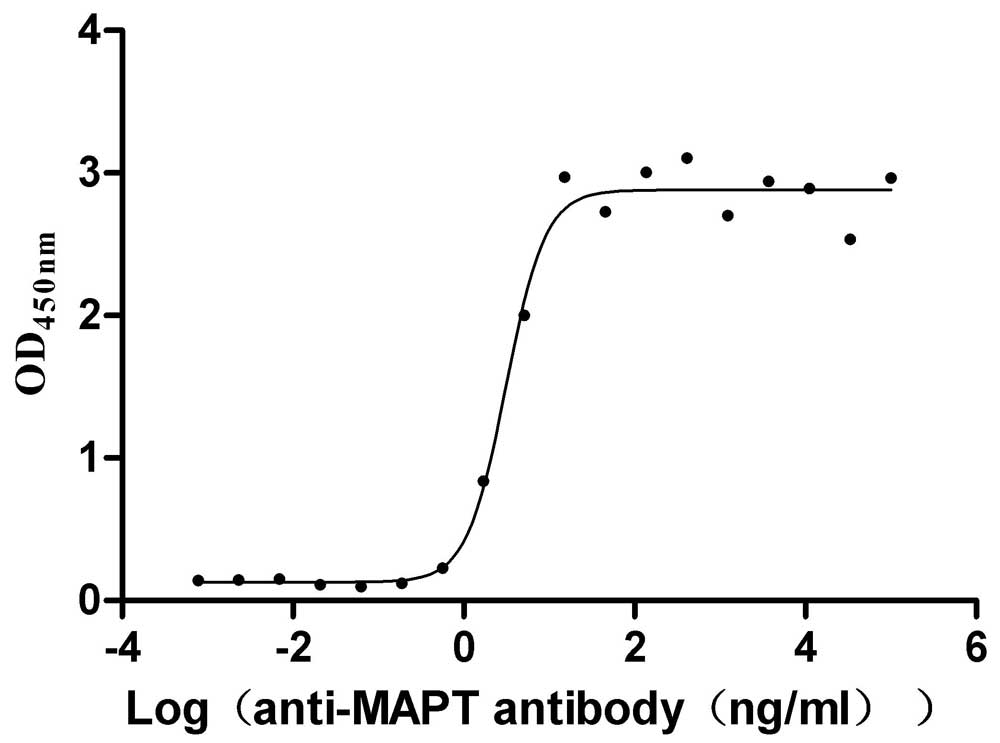Recombinant Mouse Cathepsin D (Ctsd)
-
货号:CSB-YP006187MO
-
规格:
-
来源:Yeast
-
其他:
-
货号:CSB-EP006187MO
-
规格:
-
来源:E.coli
-
其他:
-
货号:CSB-EP006187MO-B
-
规格:
-
来源:E.coli
-
共轭:Avi-tag Biotinylated
E. coli biotin ligase (BirA) is highly specific in covalently attaching biotin to the 15 amino acid AviTag peptide. This recombinant protein was biotinylated in vivo by AviTag-BirA technology, which method is BriA catalyzes amide linkage between the biotin and the specific lysine of the AviTag.
-
其他:
-
货号:CSB-BP006187MO
-
规格:
-
来源:Baculovirus
-
其他:
-
货号:CSB-MP006187MO
-
规格:
-
来源:Mammalian cell
-
其他:
产品详情
-
纯度:>85% (SDS-PAGE)
-
基因名:
-
Uniprot No.:
-
别名:CtsdCathepsin D; EC 3.4.23.5
-
种属:Mus musculus (Mouse)
-
蛋白长度:Full Length of Mature Protein
-
表达区域:65-410
-
氨基酸序列EPVSEL LKNYLDAQYY GDIGIGTPPQ CFTVVFDTGS SNLWVPSIHC KILDIACWVH HKYNSDKSST YVKNGTSFDI HYGSGSLSGY LSQDTVSVPC KSDQSKARGI KVEKQIFGEA TKQPGIVFVA AKFDGILGMG YPHISVNNVL PVFDNLMQQK LVDKNIFSFY LNRDPEGQPG GELMLGGTDS KYYHGELSYL NVTRKAYWQV HMDQLEVGNE LTLCKGGCEA IVDTGTSLLV GPVEEVKELQ KAIGAVPLIQ GEYMIPCEKV SSLPTVYLKL GGKNYELHPD KYILKVSQGG KTICLSGFMG MDIPPPSGPL WILGDVFIGS YYTVFDRDNN RVGFANAVVL
-
蛋白标签:Tag type will be determined during the manufacturing process.
The tag type will be determined during production process. If you have specified tag type, please tell us and we will develop the specified tag preferentially. -
产品提供形式:Lyophilized powder
Note: We will preferentially ship the format that we have in stock, however, if you have any special requirement for the format, please remark your requirement when placing the order, we will prepare according to your demand. -
复溶:We recommend that this vial be briefly centrifuged prior to opening to bring the contents to the bottom. Please reconstitute protein in deionized sterile water to a concentration of 0.1-1.0 mg/mL.We recommend to add 5-50% of glycerol (final concentration) and aliquot for long-term storage at -20℃/-80℃. Our default final concentration of glycerol is 50%. Customers could use it as reference.
-
储存条件:Store at -20°C/-80°C upon receipt, aliquoting is necessary for mutiple use. Avoid repeated freeze-thaw cycles.
-
保质期:The shelf life is related to many factors, storage state, buffer ingredients, storage temperature and the stability of the protein itself.
Generally, the shelf life of liquid form is 6 months at -20°C/-80°C. The shelf life of lyophilized form is 12 months at -20°C/-80°C. -
货期:Delivery time may differ from different purchasing way or location, please kindly consult your local distributors for specific delivery time.Note: All of our proteins are default shipped with normal blue ice packs, if you request to ship with dry ice, please communicate with us in advance and extra fees will be charged.
-
注意事项:Repeated freezing and thawing is not recommended. Store working aliquots at 4°C for up to one week.
-
Datasheet :Please contact us to get it.
靶点详情
-
功能:Acid protease active in intracellular protein breakdown. Plays a role in APP processing following cleavage and activation by ADAM30 which leads to APP degradation.
-
基因功能参考文献:
- Study demonstrate that PGRN interacts with the lysosomal protease CTSD and maintains its proper activity in vivo. Therefore, by regulating CTSD activity, PGRN may modulate protein homeostasis. This could potentially explain the TDP-43 aggregation observed in frontotemporal lobar degeneration with GRN mutations. PMID: 28493053
- These results suggested that Purkinje cells (PCs) were more vulnerable to CTSD deficiency in lysosomes than to autophagy impairment, and this vulnerability does not depend on the severity of axonal swelling. PMID: 28502476
- the cytosolic Cat D level and Cat D activity was significantly upregulated in response to oxygen-glucose deprivation/reperfusion exposure. PMID: 27573911
- these results suggest that inhibition of lysosomal proteases, such as CtsD, could be a new therapeutic approach to reduce renal fibrosis and slow progression of chronic kidney disease. PMID: 26831567
- The neuroectoderm specific cathepsin D (Ctsd) knock-out mice survived about 5.5 days longer. PMID: 26232697
- Data indicate that cathepsin D (CD) protein is elevated in the retinas of diabetic mice and serum of human patients with diabetic macular edema (DME). PMID: 26718887
- This study demonistrated that Mice heterozygous for cathepsin D deficiency exhibit mania-related behavior and stress-induced depression. PMID: 26092248
- Post-translational modifications drive CatD into the nucleus to cleave Histone 3 in the involuting mammary gland. PMID: 25054204
- Increased lysosomal storage in CatD KO mice causes oxidative damage in brain pericytes, subsequently resulting in an increased vessel diameter and enhanced permeability of the BBB. PMID: 25496868
- Mouse prolactin was proteolytically cleaved by Cath D between amino acids 148 and 149. N-terminal prolactin fragment and Cath D expression increased during mammary gland involution. PMID: 24598201
- Cathepsin D was not inherent to sperm themselves, but rather of epididymal origin and was presumably transported to the sperm surface via epididymosomes. PMID: 23177142
- TGase 2 may regulate the balance between cell survival and cell death through the modulation of CTSD levels. PMID: 21960143
- These results suggest that increased release/activation of cathepsin D can trigger neurodegeneration and possibly development of Niemann-Pick type C disease pathology. PMID: 23250759
- Relative position of thyroglobulin (Tg)peptide epitopes are identified based on homology to known Ctsd cleavage sites in rabbit Tg. PMID: 23315080
- c-Myb regulates matrix metalloproteinases 1/9, and cathepsin D: implications for matrix-dependent breast cancer cell invasion and metastasis. PMID: 22439866
- the connection of STAT-1 and cathepsin-D in a single compartment is relevant for protection against listeriosis. PMID: 22337873
- reduces the toxicity of advanced glycation end products PMID: 22245096
- This data showed there was no correlation between mRNA expression and activity of beta-secretase, cathepsin D, and cathepsin B in the brain of SAMR1 and SAMP8 with age. PMID: 22008266
- Data demonstrated that Abeta toxic species cross the plasma membrane, accumulate in cells and bind to a variety of internal proteins, vimentin (cytoskeleton), cathepsin D (lysosomes), GRP-78 (endoplasmic reticulum and associated membranes). PMID: 21966382
- Processing and presentation of the soluble recombinant protein fragment of MSP1 is unaffected by the absence of cathepsin D, but is inhibited when both cathepsin D and E are absent. PMID: 22053177
- cathepsin D regulates multiple proteins controlling the mitochondrial pathway of macrophage apoptosis or competing death processes, facilitating intracellular bacterial killing PMID: 21474794
- Key role of cath-D in the control of adipogenesis, suggests that cath-D may be a novel target in obesity. PMID: 21311773
- findings reveal that CatD undergoes distinct protein processing at different stages of mammary gland development PMID: 20592493
- CathD promotes 'synucleinase' activity and enhancing its function may lower aSyn concentrations in vivo. PMID: 19203374
- Extensive accumulation of endogenous alpha-syn was found in a mouse model of lysosomal enzyme cathepsin D (CD) deficiency. PMID: 19021916
- Cathepsin D plays a significant role in the removal of AGE-modified proteins. PMID: 20560835
- Data show that re-expression of cathepsin D (CtsD) within the CNS but not re-expression of CtsD in visceral organs prevented both central and visceral pathologies of CtsD(-/-) mice. PMID: 20489146
- Dysmyelination and altered trafficking of cholesterol are evident in the brains of cathepsin D knockout mice; myelin-related proteolipid protein and myelin basic protein are both markedly reduced at postnatal day 24. PMID: 19845830
- Findings show that cathepsin D is the main protease responsible for the generation of adenohypophyseal vasoinhibins and that its action can take place within the secretory granules of lactotrophs. PMID: 19819948
- Cathepsin D is specifically inhibited by deoxyribonucleic acids. PMID: 12062453
- cathepsin D increased markedly in brown adipocytes during differentiation PMID: 12117300
- mutation at aspartic acid residue 293 may result in a conformational change which affects stability, processing and transport of the enzyme PMID: 12350228
- Knockout mice without this protein show a new form of lysosomal accumulation disease with a phenotype resembling neuronal ceroid lipofuscinosis. PMID: 12440525
- acid aspartate protease CTSD is linked to the mitochondrial apoptotic TNF pathway PMID: 14739942
- Showed a functional link between cathepsin D activation, transglutaminase 1 activity and protein expression of cornified envelope proteins during epidermal differentiation. PMID: 15126630
- IGF-II modulation of cathepsin D routing is IGF-II/M6P receptor mediated PMID: 15518240
- In mouse spinal cord injury lead the up-regulation cathepsin D expression at 7 days and cathepsin D expression was observed in activated macrophages/microglia at 3 and 7 days. PMID: 15592854
- In conclusion, results from our present study showed that Hyp mouse ObCs release a greater amount of Cat D, which may contribute to the inhibitory effect of Hyp mouse ObC-conditioned media on ObC mineralization. PMID: 15958652
- Aspartyl protease substrate myoglobin requires cathepsin D activity for presentation to T cells. PMID: 16259009
- Cathepsin D deficient mice could be useful animal models for neuronal ceroid-lipofuscinosis/Batten disease. PMID: 16314482
- Ctsd is a bactericidal agent effective against the intracellular bacterium Listeria monocytogenes. A major target of cathepsin D is the main virulence factor listeriolysin O. PMID: 16424157
- vacuolar proton ATPase-dependent phagosomal activation of Cat D was required for the generation of an antigen 85B epitope by macrophages PMID: 16920965
- Cathepsin D secreted from various tissues is able to process PRL into 16K PRL outside the cell. PMID: 16959874
- Study shows that female mice with a cardiomyocyte-specific deletion of stat3 develop postpartum cardiomyopathy; cardiac cathepsin D expression and activity is enhanced and associated with 16 kDa form of prolactin. PMID: 17289576
- Abca1 expression is specifically regulated in hepatocytes, where Npc1 activity modulates cathepsin D expression and Abca1 protein translation rate PMID: 17553802
- The somatosensory thalamocortical circuitry as a particular focus of pathologic changes and provide the first evidence for synaptic alterations at the molecular and ultrastructural levels in CTSD deficiency. PMID: 18091563
- the entire 27-44 amino acid region of activation peptide is necessary for the stimulatory actions of procathepsin D on breast cancer cells PMID: 18202773
- cathepsin D is the main lysosomal enzyme involved in alpha-synuclein degradation PMID: 18702517
- Mannose receptor (-/-) liver sinusoidal endothelial cells had markedly and significantly reduced enzyme activities for four out of five lysosomal enzymes tested, i.e., cathepsin-D, alpha-mannosidase, beta-hexosaminidase and arylsulfatase. PMID: 19026003
- necessary for hepatic stellate cell transdifferentiation into myofibroblasts PMID: 19116891
显示更多
收起更多
-
亚细胞定位:Lysosome. Melanosome. Secreted, extracellular space.
-
蛋白家族:Peptidase A1 family
-
数据库链接:
KEGG: mmu:13033
STRING: 10090.ENSMUSP00000121203
UniGene: Mm.231395
Most popular with customers
-
Recombinant Human Neural cell adhesion molecule L1 (L1CAM), partial (Active)
Express system: Mammalian cell
Species: Homo sapiens (Human)
-
Recombinant Human Insulin growth factor-like family member 1 (IGFL1) (Active)
Express system: Mammalian cell
Species: Homo sapiens (Human)
-
Recombinant Macaca mulatta Microtubule-associated protein tau (MAPT) (Active)
Express system: Mammalian cell
Species: Macaca mulatta (Rhesus macaque)
-
Recombinant Human IL12B&IL12A Heterodimer Protein (Active)
Express system: Mammalian cell
Species: Homo sapiens (Human)
-
Recombinant Human Serine/threonine-protein kinase receptor R3 (ACVRL1), partial (Active)
Express system: Baculovirus
Species: Homo sapiens (Human)
-
Recombinant Human CD81 antigen (CD81), partial (Active)
Express system: Mammalian cell
Species: Homo sapiens (Human)
-
Recombinant Human Urokinase-type plasminogen activator(PLAU) (Active)
Express system: Mammalian cell
Species: Homo sapiens (Human)



















